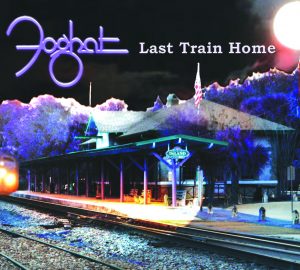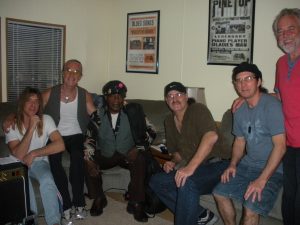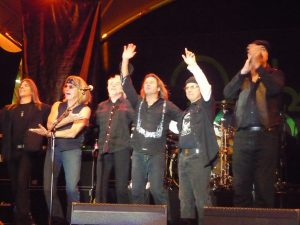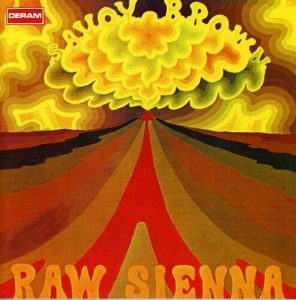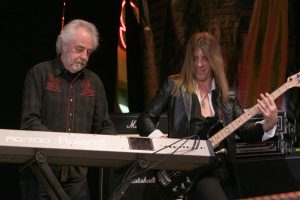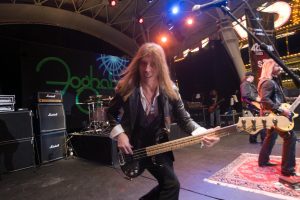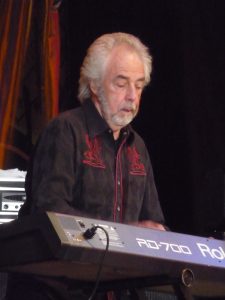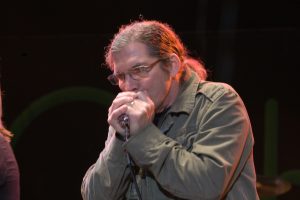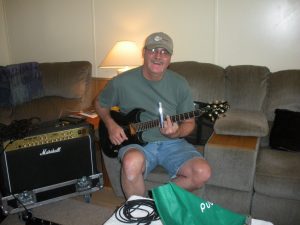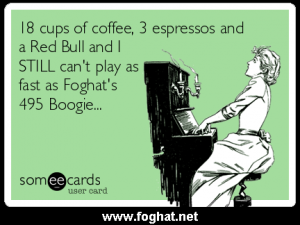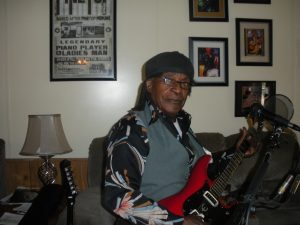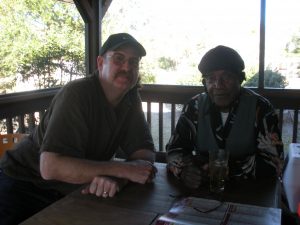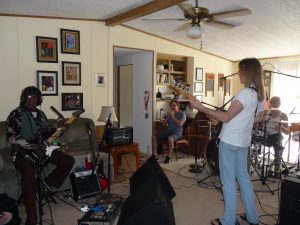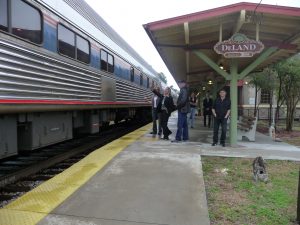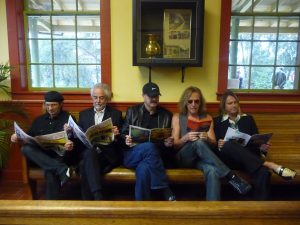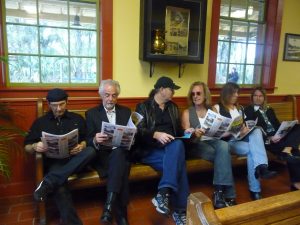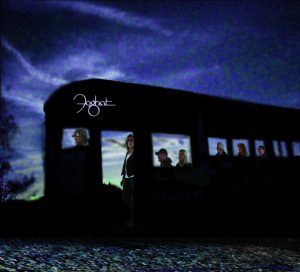Episode # 8 by Mike Mettler, official FoghatStorian 06-15-22
“We should do a Blues Album”
For many years, the above mantra was something the founding members of Foghat often said and thought amongst themselves — and occasionally shared with friends, confidants, and sometimes even the public at large. Unfortunately, the original four-man Foghat lineup never did get the chance to make that dream album prior to the February 2000 passing of the band’s original vocalist and primary blues-driving force, vocalist/guitarist Lonesome Dave Peverett. “Over the years, Dave and I — as well as Rod [Price, Foghat’s original slide guitar maestro] — had talked about doing a blues album,” confirms founding drummer/percussionist Roger Earl. “On just about every record we did, we got to do some songs written by blues artists, but we never actually did a whole record of them. That’s one of the reasons why we finally did it.”
To that end, the band eventually got to realize their collective blues-based wish when Last Train Home, Foghat’s 16th studio album, was released 12 years ago today by Foghat Records on June 15, 2010. Produced by Foghat and engineered, mixed, and mastered by the band’s ace lead and slide guitarist Bryan Bassett, Last Train Home is a master-class mixture of an even-dozen cuts of respectful covers and spot-on originals.
Truth be told, Last Train Home is a modern-day blues record for the ages, performed to perfection by the 2010 Foghat lineup consisting of the above-noted Roger Earl and Bryan Bassett along with then-lead vocalist/lead guitarist Charlie Huhn and then-bassist/background vocalist Jeff Howell. Special guests on the album include Roger’s older brother Colin Earl on keyboards, Lefty “Sugar Lips” Lefkowitz on harmonica, and the late great blues guitar/vocal legend Eddie “Bluesman” Kirkland on the album’s final two tracks, “In My Dreams” and “Good Good Day.”
For the record, Last Train Home is currently available on CD and can also be found on most digital streaming platforms. A gatefold, 2LP blue-vinyl version was indeed made available via Foghat Records at the time of release — though that particular pressing has since become somewhat of a sought-after collector’s item, as hundreds of copies were ruined due to flooding caused by Hurricane Sandy in the fall of 2012. “Our house survived but everything was flooded, and we had a foot-and-a-half of water in my drum room,” Roger reports. “All the vinyl, which had been stacked in the corner, fell over onto my drums, which were also affected. The records inside the sleeves survived, but the covers were all damaged. We basically had to give them all away for a dollar.”
Meanwhile, across the Pond, Metalville Records has reissued their own LP and CD versions of Last Train Home, which are available as imports. Foghat Records is considering reissuing the 2LP set itself someday, if demand warrants. (So please start demanding it, STAT!)
“This album was recorded in two different spaces,” continues Roger. “Some of it was done at EKO Studios here on Long Island [specifically, in Commack], but many of the tracks were done in our studio down in Florida — Boogie Motel [South, in DeLand, Florida].”
The album’s first track, “Born for the Road,” is a Foghat band original — as in, all four 2010 bandmembers share in the writing credits — and its title alone certainly speaks to Foghat’s M.O. since Day 1, now over 50-plus years and counting. “That’s such a good song,” Earl agrees. “I came up with the title, and the first couple of lines. If you’re on the record, you share in the writing —that’s how we work it. That song title seemed very suitable for us. I mean, I was born for the road — at least, that’s what they say. (Roger then adopts a lower register in order to continue with the song’s lyrics.) ‘Never give it up / ’Cause I just want to play.’ Oh, maybe I shouldn’t sing that,” he concludes with a laugh.
Could “Born for the Road” have also served as an alternate album title? “I think it was, actually,” ruminates Earl. “Charlie came up with Last Train Home, and we particularly liked that. Then Linda [Arcello-Earl, Foghat’s longtime manager and Roger’s significant other] went out with her camera and found the DeLand train station, which is what you see on the cover.” (We will hear directly from Linda later on in this story about how the clever cover art came together.)
The second track, “Needle & Spoon,” is a wonderfully slow-blues Savoy Brown song initially written and sung by Chris Youlden, and one that first appeared on that band’s April 1970 Raw Sienna album. Longtime fans will instantly recall that Roger was a member of Savoy Brown at that time, as were two other original Foghat members — Lonesome Dave (at that time, on rhythm, acoustic, and bottleneck guitar) and Tony (“Tone”) Stevens (on bass). Roger begins by citing a few key lines in the song, “And I feel alright / With my needle and spoon,” before adding, “It’s more of an anti-drug song, I think. You gotta stay away from that stuff — it’s nasty.” (Wholly agreed!)
Covering more than one Savoy Brown track on Last Train Home was no accident. “Charlie was a big Savoy Brown fan,” Roger affirms, “and he even used to come see us play live. We all loved ‘Needle & Spoon.’ Ours is a bit more up-tempo than the Savoy Brown version, though. And Chris Youlden has such a great voice! He’s one of the few English blues singers who really knows how to capture the moment. In fact, I was talking to George Thorogood a few months back, and he’s a big fan of Chris Youlden’s too. Chris sings in that lower-octave full voice — as does George.”
Track 3, “So Many Roads, So Many Trains,” originally appeared as a 1960 single by Otis Rush on Chess Records. Credited to songwriter Marshall Paul, “So Many Roads” has often been covered by a number of notable blues and rock aficionados alike, often times using just the first three words as a shortened song title. “Bryan [Bassett] always loved the way Peter Green played this song with John Mayall,” Earl observes, referring to the stirring version Green, the eventual Fleetwood Mac founding guitarist/bandleader, played on a 1967 B-side that also appeared on Mayall compilations like August 1969’s Looking Back. “We changed the arrangement a little bit, and I came up with a few things in the middle of that song. And Jeff Howell is playing bass on this one.”
Roger pauses for a moment to reflect on his and the band’s time with Howell, who sadly passed away just a few short months ago in March 2022. “Jeff was a fantastic bass player, and it’s so horrible that we just lost him,” Earl says. “And he was — how can I put this? Jeff was a little bit of a livewire onstage. The boy could dance! Everybody knew where Jeff was out there at some time or another. He never bumped into anybody, but you felt the wind when he was dancing around. (laughs) He was a good friend, actually, and I miss him. Great, great bass player.” (RIP, dearest Jeff.)
There’s also a strong family presence on the album, with Colin Earl doing his special thing on keyboards. Colin is perhaps best known for being a founding member of Mungo Jerry (“In the Summertime”), but “Colin also played on our first album,” Roger points out, referring to Foghat’s self-titled July 1972 debut LP. “We hadn’t really played much together over the years — just occasionally, when he would come over, or when he would get up and sit in on a few tunes. He wasn’t doing anything at the time of this album, so I said, ‘Well, why don’t you come down to the studio in Florida?’ He loves the warm weather. So, he came over, and actually there’s a masterpiece on here with my brother’s playing on it — but that’s further down the tracklist, and we’ll get to that one in a bit. But on ‘So Many Roads,’ he’s really tickling the ivories.”
One of the other key guests on Last Train Home is harmonica player Lefty “Sugar Lips” Lefkowitz, his nickname being courtesy Charlie Huhn. “He’s a great harp player, and a good friend of mine and Linda’s for many years,” Roger observes. “The first time I met him was when we started the Stone Blue Tour in Duluth [in Minnesota, on February 14, 1978]. We were there for a week before the tour started — it was freezing f—ing cold! — and that was the first time I met Lefty.”
As noted earlier, Charlie Huhn came up with the name for the album and its title track, another four-man Foghat original that appears here as Track 4, and it features some killer slide work from Bassett. “Yeah, he sounds so great there! Well, Bryan produced, recorded, and engineered everything, and that’s probably why it sounds so good,” Earl assesses. (Can’t argue with that logic!) “Basically, the four of us are playing together as a band on every song — and you can hear that. As long as we had the arrangement down, we only needed two or three takes at most to get it all down. ‘Last Train Home’ is a really good song, and that was either the first or second take you hear there.”
Next up are Tracks 5 and 6, which are a pair of Elmore James classics, 1961’s “Shake Your Money Maker” — a song that continues to be a mainstay in the early portion of many of Foghat’s current setlists to this day, in fact — and “It Hurts Me Too,” which was first recorded by Tampa Red in the 1930s but was made into an even more definitive version by James in 1957. Savoy Brown also covered the latter song on April 1969’s Blue Matter, with lead vocals by, you guessed it, Lonesome Dave. “We credited it that way because when Dave sang it in Savoy Brown, he said it was an Elmore James song,” details Roger. “And I take what Dave said quite literally. He always knew a thing or two when it came to blues, rhythm and blues, gospel, and country and Western. Dave was a great font of knowledge when it came to any kind of music.”
Track 7, “Feel So Bad,” is a 1954 Chuck Willis single that appeared as the first part of the legendary 22-minute live take of “Savoy Brown Boogie” that took up the entirety of Side 2 on Savoy Brown’s September 1969 release, A Step Further. And, yes, the original Foghat covered “Feel So Bad” too, on March 1973’s Rock ’n’ Roll (which was discussed in the FoghatStory about that very album as, posted here back on March 17). “The first time I ever heard it was Elvis Presley’s version [in 1961],” Earl recounts, “and it was brilliant! Elvis’ early stuff was fantastic.”
Also fantastic is Track 8, “Louisiana Blues,” a Muddy Waters classic from 1950. “That’s one of my favorites,” Earl agrees, “and we didn’t do too much to it, as we pretty much kept it to the same arrangement. Savoy Brown did it [on the above-mentioned Blue Matter], and Foghat did it many times too [in their live set, as well as on 1994’s Return of the Boogie Men and 2003’s Decades Live]. But, hey, if something works, why try and fix it?” (Again, no arguments here!)
And now, we finally get to Track 9, “495 Boogie,” the instrumental masterpiece Roger referred to earlier that showcases not only the jamming acumen of the entire band, but also the piano prowess of his brother Colin and the harp-blowing powers of harmonica master Lefty. As Earl recalls, “We had rented out some space at EKO Studios here on the Island, and everybody was in the studio together. We were just sitting there kind of messing around, so I said to Colin, ‘Play that song you used to play!’ He had a band called the King Earl Boogie Band over in England, and they would do this song. And he said to me, ‘You mean, this one?’ I said, ‘Yeah, that’s it!’ Everybody joined in, and that was one take. And that’s Colin at his finest, doing the boogie-woogie.”
By the way, if you listen closely, you’ll hear an unforced laugh near the very end of “495” that sounds suspiciously like Roger. Is that his official stamp of approval on these live-in-studio proceedings? “It probably is, yes!” the drummer replies with a laugh. “It was one take, so that must be it.”
Track 10 is a combo platter of two bonafide Willie Dixon classics put together as “Rollin’ & Tumblin’/You Need Love.” Of course, “You Need Love” also happens to have appeared as the final track on Savoy Brown’s July 1968 album Getting to the Point, where it clocks in at a rousing 7:40. “That was our rave-up number when I used to be in Savoy Brown,” Roger notes. “I did a drum solo in that one. I didn’t know what to do! They said, ‘Do a drum solo,’ and I said, ‘Alright.’ It isn’t a very good one, as I recall.” (Always the modest one, that Roger. It’s better than you might think, brother!)
Aficionados of both these legendary Dixon songs will note some variance in the lyrics, which is very much intended. Says Roger, “The band sat down together, wrote all the lyrics out, and took the ones we liked. And then we talked about how we were going to do the changes, because there’s a slightly different change in the feel when you go to ‘You Need Love.’ I do enjoy playing it — even though it’s 10 minutes long!”
Tracks 11 and 12, the album’s final two songs, are “In My Dreams” and “Good Good Day,” both of them by Eddie Kirkland, the beloved master bluesman who sadly passed away at age 87 in a car accident in February 2011, not long after Last Train Home was released.
Kirkland made his bones playing and touring with John Lee Hooker from 1949-62 before branching out as a quite determined solo blues artist, driving himself in his own car to pretty much every gig he ever did until his passing. “We actually recorded seven or eight songs with him,” Roger details. “We just sat there and played! One thing I recall from when we were working on ‘Good Good Day’ is that, being a drummer, I have this thing about counting off the songs. I would go, ‘One, two, a-one, two,’ and Eddie would look at me like, ‘The f– are you doing?’ (laughs) Eddie also liked to change the arrangements, so that’s probably why I wasn’t allowed to count the songs off! Eddie told us some fantastic stories too.
Linda filmed and recorded a number of them while we were sitting together on the back porch of our studio down in Florida. We’ll have to share those stories with everybody someday.” (Yes, please! I’ve heard tales about Eddie fixing cars on show days as well as the potential, er, problem with people who may have wronged him! So perhaps such intriguing tales should all go in our book to come, hmm. . .)
Roger is grateful for the time he and the band got to spend with Eddie over the years. “He had such a wonderful, incredible life,” Roger notes. “He was a bluesman to the nth degree. Such an incredible character, and fantastic to play with — and a great guitar player as well.”
One other important detail to note about Last Train Home, before we go — early on in this story, I mentioned the album’s striking train station cover art. You should also take special heed of the full recording band reading newspapers and/or magazines inside the train station itself in a photo that graces the inner sleeve. Manager Linda Arcello-Earl, who did all artwork and photos for the release, picks up the tale.
“I had been looking for a place, a train station, to do the cover shot for the record. I was driving all over the place, looking around. It turns out the DeLand Station, the train station in our town, was two miles away from the house,” she notes. “So, we were going to go to the train station the next morning after recording to do the filming.
“Jeff Howell was not a big drinker at all,” Linda continues. “The rest of us drink wine among other things though. So he’s sitting with Colin, drinking wine after we had finished recording. I’m looking at him and I said, ‘Jeff, you’re getting a little wasted!’ And he’s says (slurs her words on purpose in Jeff’s voice), ‘Yeah, well, Colin’s great!’ He’s bonding with Colin, and they were having a really great time just chatting and laughing!
“The next morning, when we’re getting ready to head to the train station, Jeff was extremely hung over. We’re all driving down to the train station, and he went with Bryan, who had to stop a few times for him. Inside the train station, they had all these great seats — they’re all almost like church pews — and I used some of them in the pictures in the album. I sat them all down, and they all had newspapers. I’m like, ‘Everybody — cross your legs, look at the magazine or the newspaper.’ Jeff was in the men’s room for the first few shots.
Then he finally comes out and I’m like, ‘Ok, Jeff — sit down, cross your legs, look at the magazine,’ but he’s there talking to Colin and doing all this other stuff! He was really funny. ‘Jeff, look at the magazine!’ In most of the shots, he’s looking everywhere else. But we did get a lot of fun shots. It was a great time, and Jeff was great too. We really miss him.”
SIDE NOTE: Sadly we lost Jeff on 3/10/22 after a long bout of illness resulting from his fight with Lyme Disease! His struggle with Lyme spanned over 2 decades but Jeff still managed to perform flawlessly and give it his all when called upon. His wife Linda shared this with us! “We later came to find out that the severity of that hangover was because the body can’t tolerate alcohol when you have Lyme Disease. It breaks down into sugars, which feed Lyme. It was shortly after this that he quit drinking altogether. I think Lyme was responsible for many issues that occurred with him.” He fought an amazing fight until the very end!
All told, Last Train Home is a stellar addition to the Foghat canon. It’s an album that has a deep spiritual connection with Foghat’s original, blues-entrenched legacy as well as with the band’s direct descendants known as Earl & The Agitators, a side project that is in fact comprised of the Foghat of today — namely, Earl, Bassett, singer/guitarist Scott Holt, and bassist/vocalist Rodney O’Quinn.
“I have fond memories of making the Last Train Home record,” concludes Roger, “and of working with Eddie, and especially working with my brother Colin — and of course with Jeff Howell, who was fantastic. This album was something I always wanted to do. In fact, we could probably do another one, now that we’ve got Scott Holt in the band. Not unlike Dave, he has an immense knowledge of blues records and blues songs. In fact, earlier today, I sent him some lyrics to work on. We’ve got seven or eight basic ideas that we’ve done some roughs on down in Florida, and we’ll hopefully get it all done by the end of the year.”
Much like the opening song says, Foghat is a band that was born for the road, and Last Train Home remains a powerful record that shows everything they can do in the blues idiom — and more. Based on Roger’s foreshadowing of the band’s next record, I hear the very next Foghat blues train a-comin’ — and I for one can’t wait for it to pull into the station.
Keep an eye on this space for many more in-depth FoghatStories to come — all of which are the precursors for the officially authorized Foghat biography by author Mike Mettler that we currently have in the works! Stay tuned!!
[end]

